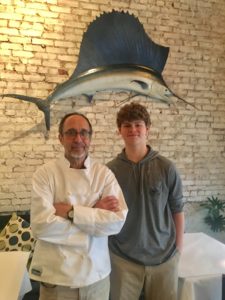
This past week we hosted an intern at Tsunami as part of a mentoring exercise through Grace-St. Luke’s Episcopal School. Stagiaire is a French term that refers to a cook who works a brief, unpaid stint in another chef’s kitchen. It can also refer to a trainee or intern. It is a fairly common practice among upcoming cooks in the restaurant industry, where it is often referred to as “doing a stage”, as in “I would love to do a stage at the French Laundry.” It’s a good way to learn new techniques or hone your cooking skills. Or just to find out what it’s like to work in a different environment under a different chef. It’s also often good for the staff of the restaurant hosting the stagiaire. It’s an opportunity for the crew to share their knowledge and help lift up a fledgling cook. But it also offers an outlet for all the tired jokes that everyone on the staff has already heard. Not to mention a new victim for all the typical kitchen pranks that nobody else falls for anymore, like “Go get the grill extender from dry storage.” Or “Bring me the the left-handed spatula, this is a right-hander.” Or “Empty all of the hot water out of the coffee maker before you leave tonight.”
Of course we didn’t pull any of those pranks on Bruce, our young stagiaire. My staff was professional and mature and didn’t use any much profanity in his presence. Truly, my staff was very accommodating and professional and I think the young man was well looked after. On his first day, I sat down with him and quizzed him on what he expected out of the experience and how we could maximize his experience. Then I asked him why he chose Tsunami to do his internship, hoping, of course, for something like “I wanted to intern at my favorite restaurant.” But it turns out that he is in the same class as my niece and she recommended Tsunami to him. He asked me if I knew a girl named Emma Couch. “You mean my niece? Yes, I do know her as a matter of fact.” I asked Bruce if he cooked much at home and if he was interested in pursuing a career in the restaurant business. He said his dad did most of the cooking at home, but he was interested in the restaurant business. “Well, we’ll see how you feel after a couple of days here” I thought to myself. Or I think I thought it. I could have actually mumbled it. Then it was off to the kitchen to start his stage.
Bruce spent his first shift shadowing me through the kitchen listening to my stream of consciousness regarding the operation of a restaurant. Jeez, where to even start? I began with introductions all around. Bruce met the kitchen staff first, then was introduced to the front of the house staff by ones and twos as they showed up for the shift. I explained about the division of labor between the FOH (front of the house) and the BOH (back of the house). I explained that in most (sorry, every) restaurant I’ve ever worked in there was animosity between the FOH and the BOH. “Like cats and dogs” I told him. But not here, I explained. I learned early on in the history of Tsunami that things went a whole lot smoother when we maintained an environment of mutual respect in the place. Then I cut some tuna and explained about the importance of food cost and how to figure the food cost percentage on a menu item. I told him about “loss leaders”, menu items that you sell for little or no profit to attract people. I explained how you design a menu so that you have other items that have a high profit margin to make up for loss leaders.I talked about the importance of cost control and portion control and labor cost and menu balance. His eyes started to glaze over, so I told him he should sit down and eat.
After dinner it was time to do some dicing. I demonstrated how to dice an onion. I showed him different cuts with a carrot: batonette, julienne, small dice, brunoise. I taught him some French culinary terms like mirepoix and mis en place. I let him have a go at dicing some vegetables, but not before teaching him the importance of keeping his fingertips tucked in away from the blade of the knife. I didn’t let him have the knife for long. He needs to practice that at home. With his own band-aids. We made a soup together in which we used the mirepoix that I had diced earlier. I explained the importance of layering flavors in a dish so that the end result is greater than the sum of its parts. I explained to him, just in case he hadn’t picked up on it yet, that kitchen work involves a whole lot of drudgery and repetition. It’s not all flames and flash and squeeze bottles full of colorful sauces like it is on the Food Network. This is the real deal. Finally Bruce’s dad showed up to take him home and I think he was glad to have day one behind him.
Day two was much the same as day one, lots of repetition, drudgery and attention to detail. I talked to him about the importance of composting and recycling. He spent time with my pastry chef and learned how we make our bread. He learned terms like “bloom” and “proof”. He learned how to shape a bread loaf by hand. He watched my pastry chef incorporate a ridiculous amount of butter into a batch of brioche dough. He watched her make a 10 layer Russian honey cake. He learned how to make our herb vinaigrette. He picked some spinach. A lot of spinach. He has a newfound appreciation for how much work it takes to put a salad on a plate. He learned about plate presentation and the importance of a well balanced, well designed plate of food. We made another soup together. He cut some stems off of a lot of shiitake mushrooms. He used some more of my band-aids. I think he started to reconsider his future career options.
By day three, Bruce was beginning to grasp the flow of a shift. He’d seen the flurry of activity that proceeded the beginning of service. The sweeping and mopping of the floors, the setup of the dining room and the bar, the organization of the reservation chart, the massive amount of food prep, the setting up and the organization of the hot line. He had a good sense of the immense amount of work it takes before the doors of the restaurant even open. What he hadn’t seen yet was the finished product, the plates of food as they left the window in the kitchen. So shift three was all about seeing the operation from the point of view of the expeditor. The expeditor in a commercial kitchen is the person who stands in the window or “pass” of the kitchen and directs the flow of food. He or she is the person who pulls the tickets off the machine when they ring in, calls out the orders, fires the different courses when needed and makes sure there is someone on hand to run the food to the right seat number at the right table. The expeditor is also the last one to lay eyes on a plate before it goes out of the kitchen and is responsible for making sure that the plates are ready for the dining room. This includes making sure that the presentation is right, that all the components are on the plate, the proteins are all cooked to the proper temperature, the plates are garnished when necessary, and the plates are wiped clean of any drips or dribbles.
It was a lot to take in over the course of three nights, but Bruce bore it well and I think he left us with a much better understanding of the industry. It was a valuable exercise for my staff and myself as well. It’s always fun to have a fresh face in the room. So many of my staff have been with me for so long that I tend to take things for granted. I know that my staff knows what they are doing and they need very little from me in the way of guidance or instruction. Having an intern in the kitchen forced me to review my knowledge and to really reexamine my skill set and make sure that I was passing along those principals in a clear and comprehensive manner. It also made me feel like a mentor again. And that is a very important aspect of this business. Thanks, Bruce! Hope you had as much fun as we did.

